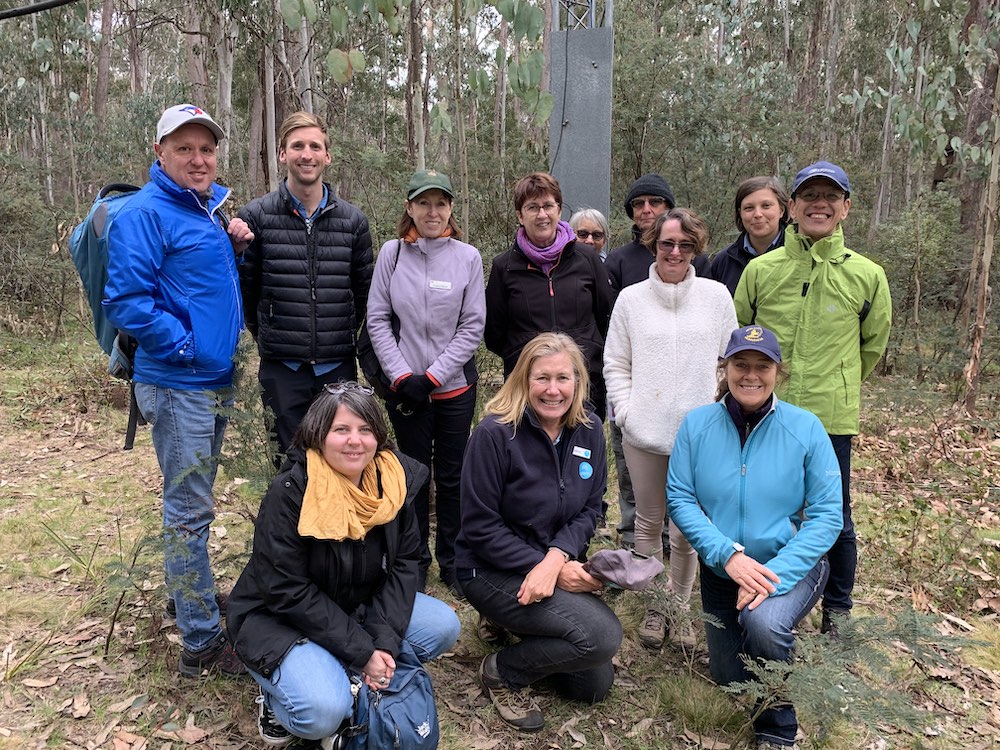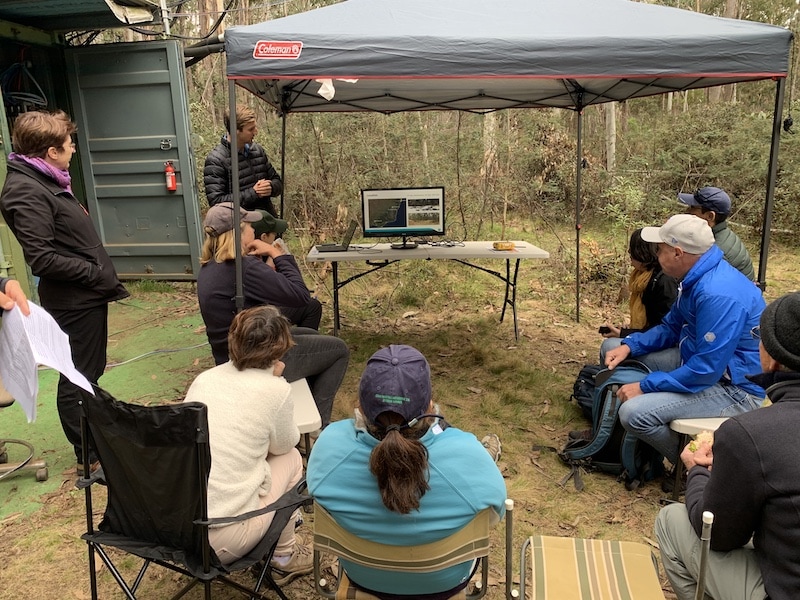In December 2019, government agencies and international science organisations joined local community members for a guided tour of TERN’s Tumbarumba SuperSite—one of the world’s most important environmental monitoring systems for ensuring the accuracy of global environmental satellite products. Read about the trip and check out the front-page feature in the Tumbarumba Times.
On 7 November 2019, local community groups joined scientists from site partners, the CSIRO, the Department of Environment and Energy, the International Long Term Ecological Research Network (ILTER), the Group on Earth Observations Biodiversity Observation Network (GEOBON) and LifeWatch ERIC for a guided tour of TERN’s Tumbarumba SuperSite in NSW’s Bago State Forest.
The tour was part of TERN’s participation in the Group on Earth Observations (GEO) Ministerial Summit in Canberra, which also included representation at the ‘NCRIS-pod’ in the Australia exhibition and participation in a number of official side events, including an MIT-led modelling workshop with our NCRIS sibling AuScope.
Former shire councillor and past president of the Tumbarumba Chamber of Commerce, Tony a’Beckett, attended the field trip and said that it was a revelation to find out that such globally important research was being conducted in his own backyard.
“My wife and I were privileged to be able to listen to the scientists as they explained the work they are doing and how they are collaborating with their European counterparts to provide data that is being used in the IPCC monitoring and reporting.
This monitoring station with its 70-metre-high tower is regarded as the second most important station in the world and its continued operation is essential and must not be allowed to lapse through lack of funding or for any other reason.”
Tony a’Beckett

(L-R back row) Jacco Konijin (LifeWatch); Will Woodgate (CSIRO); Beryl Morris (TERN); Helen Cleugh (CSIRO); Susie a’Beckett; Tony a’Beckett; Kylie Galway (Department of the Environment and Energy); Jess Hodgson (CSIRO); Hideaki Shibata (ILTER) (L-R Front row) Laetitia Navarro (GEOBON); Jacqui Stol (CSIRO); Sue Fyfe (Department of the Environment and Energy)
TERN’s Tumbarumba site is one of the world’s key vegetated sites to support global satellite monitoring programs and is considered critical in ensuring that global satellite products provide accurate information for the Australian continent.
In fact, in 2018 the international Committee on Earth Observation Satellites (CEOS) ranked the site as number two in their list of top 55 global sites for the calibration and validation of satellite-derived global bio-geophysical data products—number one is TERN’s Cumberland Plain SuperSite and number three is TERN’s Alice Mulga SuperSite. Seven of the top ten sites are TERN sites.
TERN and site partners, CSIRO, are collaborating with NASA and the European Space Agency (ESA) on a number of current and planned satellite missions that will lead to a better understanding of how climate change will affect water use by plants and the implications for agricultural and natural ecosystems.
ILTER Chair, Dr Hideaki Shibata from Hokkaido University in Japan, said that the field visit was a fantastic experience and valuable opportunity to hear from experts from around the world on the latest research coming from the forest site.
“Carbon dioxide uptake by forests is one of the most important ecosystem functions to mitigate global climate warming. And, this site has a significant role in supporting key environmental and climate research, especially on CO2 exchanges.
The integrated approaches of carbon cycling research with satellite remote sensing, drone observation, and ground intensive measurements of the ecosystem and biodiversity at Tumbarumba is quite powerful and valuable in addressing important research questions for global climate change projects.
I hope that the Tumbarumba site and the researchers using its equipment and data will continue to contribute to the global research networks and programs, such as ILTER, a global site-based and long-term ecosystem network to solve various ecological and socio-ecological problems around world.”
Dr Hideaki Shibata, ILTER Chair
Keep an eye out in future editions of the TERN newsletter for more news on the further development of the NCRIS-enabled national research infrastructure at Tumbarumba.
Thanks to @TERN_Aus and @CSIRO for organizing a great and inspiring visit of the Tumbarumba super site! https://t.co/8XobNWtLsk
— GEO BON (@GEOBON_org) November 7, 2019

The trip to the Tumbarumba SuperSite was also featured in the Tumbarumba Times

Visitors exploring the Tumbarumba SuperSite and its suite of ecosystem monitoring equipment







